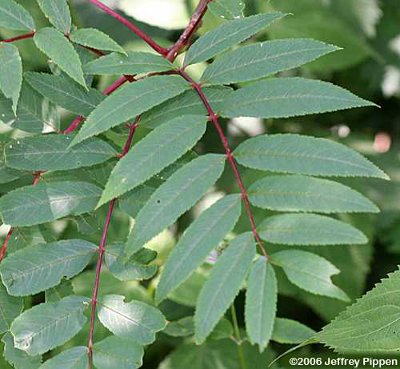American Mountain Ash Tree
Category: Deciduous Trees

Facts about American Mountain Ash Tree, "Scientific name for American Mountain Ash Tree is Sorbus americana". The American Mountain Ash is a member of the rose family and is not related to the true ashes. It is a small, deciduous shrub or tree which is native to northeastern North America. It can be found growing around the areas of northern Michigan, Newfoundland, New Jersey, North Carolina and Georgia. It can grow naturally in a pyramidal shape with an open round-shaped corn attaining a height of about fifty to eighty feet (15.24 to 24.38 meters) and a spread of fifty to seventy feet (15.24 to 21.33 meters).
A Full grown American Mountain Ash Tree can absorb as much as 48 pounds (21.77 kg) of carbon dioxide a year. The same American Mountain Ash Tree could also produce enough oxygen in a day for two people. In a single day, a large American Mountain Ash Tree can drink up to 100 gallons (378.5 liter) of water from the ground and discharge it into the air.
You can tell a American Mountain Ash Trees age by the number of growth rings inside. Growth rings size shows what kind of conditions accrued that year, the temperature and if it was a dry or wet year.
Bark of the American Mountain Ash Tree protects it from the elements and is made up of dead cells.
The American Mountain Ash Tree has a light brown to gray bark which can be smooth during the earlier stages of the plants growth becoming rough with scaly patches, splits and cracks as it matures. American Mountain Ash Tree branches are gray in color, smooth and thick. On the branches are pinnately compound, alternate leaves with lance-shaped leaflets which can be up to two to three inches (5 to 7.6 cm) long.
The American Mountain Ash Tree leaves can grow up to a length of about six to ten inches (15.2 to 25.4 cm) with sharp tipped, fine margin. Individual odd pinnate leaves are six to ten inches (15.2 to 25.4 cm) long and have about nine to seventeen. There are two to four inches (5 to 10 cm) long serrated leaflets which are green in color with a grayish-green color underneath. The leaves turn yellow as the American Mountain Ash Tree matures into fall.
The American Mountain Ash Tree produces blossoms around the months of May to July. These dense, clustered-blossoms are white in color with individual blooms producing five flowers which can be a 1 1/4 inches wide (3.1 cm). The American Mountain Ash Tree flowers give way to brightly colored orange-red fruit berries. The berries mature to ripen in late summer and do not fall together with the leaves.
The American Mountain Ash is a hardy tree plant which does best in USDA zones of three to nine. They can establish in acidic, moist to well drained soils rich in organic materials and in full sun. The American Mountain Ash Tree cannot tolerate urban pollutions, dry soil conditions and humid and hot summers. However, it can tolerate cool mountain climates.
American Mountain Ash Tree roots usually grow two to three times the width of the tree branches. The ideal time to fertilize your Tree is in late fall or early spring. If you want to transplant a American Mountain Ash Tree do it in fall, this is ideal for most trees.
American Mountain Ash Tree leaves are made up of many colored pigments, green chlorophyll hides the colors during the growing season of spring and summer. As days get shorter and cooler temperatures come in the fall, it cause the chlorophyll to break down and than the other color pigments can be seen.
American Mountain Ash Tree growth is referred to as Meristem (The undifferentiated embryonic plant tissue from which new cells are created, as that at the tip of a root or stem). This tissue can be found at the tips of shoots and leaves. Inside the stem growth in thickness occurs at the vascular cambium.
American Mountain Ash Trees make their own food from sunlight, carbon dioxide, water, and nutrients from the soil.
The American Mountain Ash Tree can be used as an ornamental tree. Its berries are food for bird and some wild animals. They can also be used to make jellies and jams.

 Back To Category Deciduous Trees
Back To Category Deciduous Trees